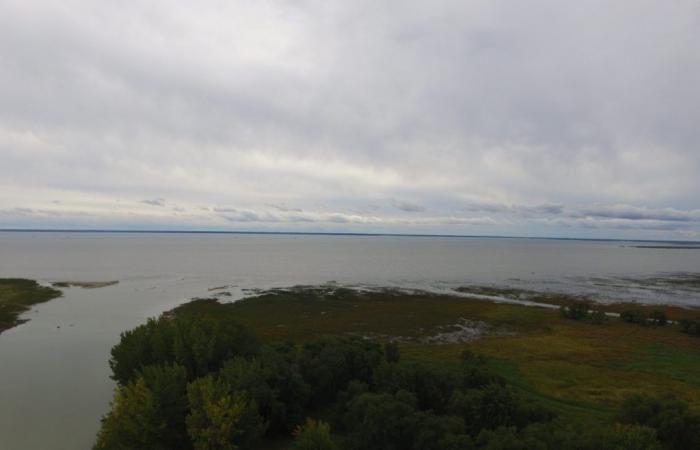After six years of research work, the multidisciplinary center of expertise in sustainable management of the coast of Lake Saint-Pierre has delivered its findings and recommendations with a view to implementing agriculture that respects the ecosystem of Lake Saint-Pierre. Pierre and the restoration of priority coastal environments.
More than a hundred researchers, students and professionals from the University of Quebec at Trois-Rivières (UQTR), Laval University and McGill University participated in the research carried out within the Pôle d multidisciplinary expertise in sustainable management of the Lake Saint-Pierre coastline since 2018.
Their summary report, presented on Wednesday, makes four major recommendations, namely to protect and rehabilitate natural environments, cover low coastal areas with perennial vegetation, adapt the management of annual crops in high coastal areas, as well as preserve the soils of watersheds of tributary streams against soil erosion and gullying.
Nearly 3,800 hectares of wildlife habitats have been modified since 1950 on the coast of Lake Saint-Pierre, mainly for the benefit of agriculture.
“The challenge is to obtain better coexistence between natural environments and cultivated environments. In recent decades, we have moved from an agricultural environment with forage plants to an annual crop mainly composed of corn and soybeans. This has changed the balance of the environment and makes it less suitable for the reproduction of certain species, including perch and pike,” underlines Stéphane Campeau, researcher in the environment and wildlife axis of the Pole and professor at the Department of Environmental Sciences at UQTR.
“The impact of these major crops is disproportionate compared to the ecosystem services of the coastline. It is essential to expand conservation efforts in order to better protect existing natural environments against any new pressure, to rehabilitate degraded environments and to increase the connectivity of these environments with the river. If there is a priority place to protect, it is the coastline of Lake Saint-Pierre,” adds Mr. Campeau, comparing the sector to the Amazon on a Quebec scale for the richness of its ecosystem.
The environments most conducive to the restoration of coastal ecosystem functions would be natural environments, old meadows and strips of perennial vegetation. Conversely, bare soils or soils with little crop residue, which are harmful to the ecosystem, should be avoided. In low coastal areas, which are more frequently flooded, the Pole recommends a permanent vegetation cover offering better spawning habitat for fish in spring.
On the agricultural side, the work of the Center highlights that it would be preferable to opt for forms of cultivation allowing the maintenance of permanent vegetation of sufficient height and density in the fall.
“The agro-environmental practices to be favored would include working the soil in the spring after the flood, rather than in the fall, the planting of intercropping cover crops in corn and soybeans, as well as the establishment of vegetation strips perennial along the banks of watercourses and ditches along cultivated fields. These measures would promote the creation of a variety of habitats favorable to biodiversity”, mentions Caroline Halde, researcher of the axis agriculture du Pôle and professor at the Faculty of Agricultural and Food Sciences at Laval University.
Supporting farmers
Although a transitional regime, established in 2022, authorizes the practice of agriculture on the coast of Lake Saint-Pierre under certain conditions, this complicates environmental rehabilitation, notes the Pole.
“We need to re-establish dialogue between the government and the territorial stakeholders concerned,” says Julie Ruiz, researcher for the axis. socio-economics of the Pole and professor in the Department of Environmental Sciences at UQTR. Before the transitional regime was put in place, there were several local coastal environmental rehabilitation projects with various organizations. After the transitional regime, we saw a sudden stop to local projects. The agricultural community is also more united in the regulatory challenge. We are also seeing an increase in claims for compensation for changes in practices. It is important to have a minimum consensus around environmental regulations. »
The absence of a global and long-term vision prevents the creation of a dynamic of collective commitment towards the preservation of the ecosystem of Lake Saint-Pierre, notes the Multidisciplinary Center of Expertise in Sustainable Management of the Lake Coast Saint Pierre.
“We have observed that agricultural producers receive little support, in terms of financial assistance and agricultural advice, in the first steps leading them towards the adoption of improved and sustainable practices in the coast of Lake Saint-Pierre. In addition, the better the practices of agricultural producers from an environmental point of view, the greater their economic losses and their socio-technical challenges,” reports Ms. Ruiz.
“During meetings with producers, the repurchase of land was often presented as an option to be discussed. A wall-to-wall solution is not possible. There are solutions to be implemented flexibly to move forward gradually, but we suggest that this be discussed locally, by sub-region,” she adds.
Improving territorial governance, adopting a progressive approach focusing on modest objectives and frequent deadlines, as well as maximizing the scope of agricultural advice are among the proposals put forward by the Pole.
The Pole’s recommendations and findings can be consulted at www.uqtr.ca/polelsp.
Remember that the multidisciplinary center of expertise in sustainable management of the Lake Saint-Pierre coastline was created in July 2018 by the government of Quebec, with the granting of a budget envelope of $4.66 million to the three participating university establishments to the project. The Center’s research programming includes three axes to respond to the agricultural, ecological and socioeconomic challenges of Lake Saint-Pierre.






